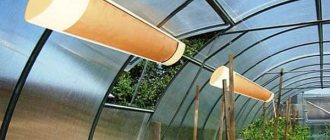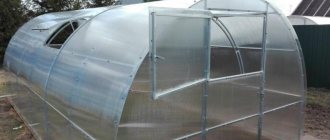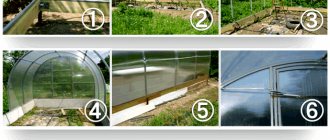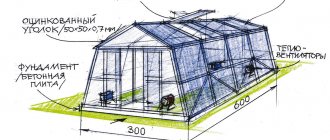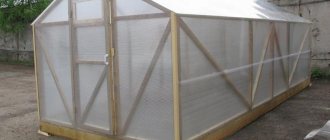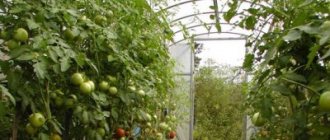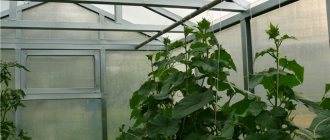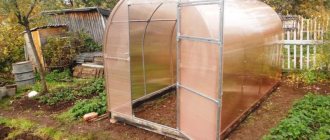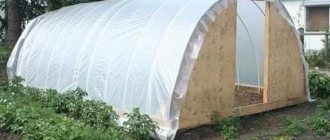A considerable number of owners of personal plots, having gained experience in cultivating plants, are beginning to think about creating a business for growing and selling vegetables, berries and flowers. Obviously, the possibilities of your own garden are clearly not enough for this - its area is small, and cultivation in the open ground is inextricably linked with many risks that affect the harvested crops, and therefore the stability of earnings. Therefore, to grow cucumbers, tomatoes, strawberries, flowers and other plants, it is advisable to build your own industrial greenhouses.
Industrial greenhouse, inside view
Are you one of these summer residents who has a dream of owning their own agricultural business? Then this material will help you find out how industrial greenhouses work and how they differ from their “smaller brothers.”
Industrial greenhouses made of polycarbonate
Arrangement of seedlings
We take the seedlings and arrange them so that all the plants get the light and the leaves of the seedlings do not intertwine or even touch. This is necessary to provide light and warmth. This will be the best care.
The plant is growing and needs to be planted in time in the main soil - greenhouse soil from the container, because the stems can stretch out enough and even 2-3 fruits will form on one cluster, and the plant itself will spend entirely on the formation of these particular fruits. We constantly remove small stepsons. The upper stepson can be left; it forms a second stem located next to the flower stem.
When transporting to the dacha, so that the plants do not break and feel comfortable, try not to water the seedlings a few days before transportation; it is better to dry them, the stems will not be brittle and the plant will better tolerate a stressful situation.
From the middle or end of May, you can safely begin planting tomato seedlings in a film greenhouse or greenhouse. If you have a warm greenhouse, heated, and if you have a warm heated bed, using biofuel, based on plant residues, then you can start planting tomatoes in early May. It all depends on the specific greenhouse and weather conditions.
A prerequisite for good production and good fruiting is that soil and bed preparation must be carried out immediately before planting tomato seedlings. We dig up the ridge, loosen it, level it with a rake, then you need to add mineral fertilizers so that fruiting is abundant and good.
Construction of industrial greenhouses - frame
Based on their shape, there are three types of industrial greenhouses, presented in the table below.
Table. Basic forms of industrial greenhouses.
| Name | Description | Advantages |
| Arched or arched | The cross-section of the greenhouse has a semicircular shape. It consists of frame arches connected to each other using horizontal ties. | Resistance to wind loads, less consumption of materials for the frame, the ability to create structures of huge sizes. Regardless of the time, sunlight hits the roof and is scattered inside. |
| Gable | A greenhouse of a standard shape with rectangular walls and a roof with two slopes, like a country house. | The same height of the walls throughout the entire area of the building. A very durable structure, but at the same time requiring a large amount of materials for the frame. |
| Lancet | A subspecies of the arched greenhouse, in cross-section it has the shape of a pointed arch, elongated in height and pointed at the end. | The advantages are the same as those of arched greenhouses, while less snow accumulates on the pointed roof. |
Arch-shaped industrial greenhouses
Industrial greenhouse with gable roof
Sketch of an industrial greenhouse with a lancet shape
The vast majority of such structures use steel or, to be more precise, steel profile pipes and an angle profile as the material for the frame. This is due to the fact that these materials are superior in strength, durability and cost. In addition, today builders have gained vast experience in the construction of such metal structures, so the construction of another frame for an industrial greenhouse does not require a lot of time and effort or the involvement of some rare and specific equipment.
Construction of an industrial greenhouse with a metal frame
To strengthen the frame and increase its strength, double arches are often used
To create sufficiently large structures with their own microclimate, supported by ventilation and heating, several arched or gable spans are combined together. Thus, multi-span greenhouses of enormous area are obtained, shown in the images below.
Multi-span greenhouses, diagram
Multi-span greenhouses
Russian LED
Since in greenhouses a significant part of the load on production costs comes from energy costs (in Russia, depending on the region, their share in production costs ranges from 20 to 70%), the main way to reduce costs for greenhouses is traditionally the “light arms race”. The world's leading lamp manufacturers did not seriously look towards LEDs until the beginning of the new century (sodium lamps are now the most popular). Discovered back in 1907, the principle of the luminescent glow of certain semiconductors when electricity is passed through them received its first practical application in the 1960s in the form of indicators called Light Emitted Diodes (LED), the radiation of which was a hundred times lower than that of conventional incandescent lamps . But everything changed in the late 1980s thanks to the research of a group of scientists led by Russian academician Zhores Alferov , who discovered fundamentally new semiconductor materials that made it possible to increase the luminous efficiency, intensity and service life of LEDs by a multiple. The work deservedly received the Nobel Prize: for the first time, semiconductors appeared capable of emitting not only red, but also orange, green and other colors of the spectrum. Later, the Japanese found a way to extract blue light from a semiconductor - and the spectrum was closed. A group of scientists from the Leningrad Electrotechnical Institute (LETI) led by Yuri Tairov , who in the 1980s created an economical technology for growing especially strong homogeneous silicon carbide crystals for LEDs, also made a great contribution to the development of LEDs. Scientists emigrated to the USA, where they continued development in the newly created company Cree, now one of the world leaders in LED lighting ( see “America has proven that we can”, “Expert” No. 45 for 2012
). Created in the late 1990s, Cree in 2004, based on Russian developments, released the first mass-produced, inexpensive and, most importantly, more economical LED lamps, which quickly took over streets, houses, industrial enterprises and shopping centers (in Russia alone, up to half of the lamp market is accounted for LED). But Cree did not retain its leadership for long: competition with such large manufacturers as the Japanese Nichia, the Dutch Signify (formerly Philips Lighting), the German OSRAM, the South Korean Samsung LED, etc., led to a significant reduction in the cost of LED lamps, an increase in their luminous efficiency, energy efficiency, reliability, and durability etc. So they became available for greenhouse lighting.
According to forecasts, only LEDs will provide a significant increase in light output
Source: Ministry of Energy
Industrial greenhouse - choosing a location and foundation
After registering a private enterprise or farm, you need to select and purchase a plot on which the future agricultural complex will be located. Here are some recommendations for a location for an industrial greenhouse in the form of a list.
- Slope - the site should be as level as possible, with minimal landscape unevenness that can be easily removed. The permissible slope value for such buildings is 0.004%.
How to place a greenhouse on a site according to the cardinal directions
- Proximity to a water supply or pond - plants in an industrial greenhouse will need a lot of moisture. At the same time, it is undesirable to locate an agricultural complex too close to a river or lake, otherwise it will be a violation of the sanitary zone. Subsequently, complaints may be received about this, you will be visited for inspection and ordered to dismantle the greenhouse.
- Satisfactory indicators of air purity - it is undesirable to build an industrial greenhouse near a coal-fired power plant or a large factory; the substances they emit into the atmosphere will reduce the yield and make the grown vegetables and berries unsafe for humans.
- The agricultural complex should be located not too far from roads and power lines, otherwise the costs of laying infrastructure and communications will increase significantly.
- Wind conditions. The ideal situation is when the site for industrial greenhouses is protected by the landscape from winds from the north side (and is not located in a lowland). If such “protection” is absent, then the owners of the agricultural complex can install special barriers or plant a number of trees that will slow down and delay cold winds.
- Fertile soil - if it is available, the costs of transporting land and fertilizers for the beds of an industrial greenhouse are reduced.
The soil on the site must be fertile
Advice! If you are planning to build an industrial greenhouse in a region located north of 60° latitude, then orient the structure with its long sides to the south and north, and its short sides to the west and east, respectively. If located in the southern regions, the orientation should be reversed.
A forest belt planted on the northern border of the site can hold back the cold wind
After this, you should begin drawing up a project for an industrial greenhouse, creating drawings and approval. Considering the size and cost of the structure, it makes sense to seek the services of professionals involved in the design of buildings made of metal structures.
The next stage is excavation work and arrangement of the foundation. For the simplest seasonal structures with polyethylene sheathing, you can do without it (but not advisable). For the rest, especially year-round greenhouses, it is mandatory. In most cases, preference is given to a strip concrete foundation lying below the freezing depth of the soil - this way the ground inside the greenhouse is protected from the effects of cold in winter.
Greenhouse frame on foundation
Recommendation! For regions with a very harsh climate, you can reduce the cost of heating a greenhouse by “sinking” it into the ground. The result is a thermos greenhouse, as in the image below.
Greenhouse thermos
Industrial greenhouse "Farmer-7.5" - design
Let's consider one of the standard models of industrial greenhouses supplied to the modern market. This is a structure called "Farmer-7.5". It is an arch-shaped industrial greenhouse with a frame assembled from galvanized profiles and bolted fastenings. All structural elements are equipped with tie beams and cross members, giving the structure high strength and resistance to snow loads.
Scheme of the industrial greenhouse "Farmer-7.5"
The height of "Farmer-7.5" is 3.8 m, width is 7.5 m, length starts from 4.2 m. Moreover, the latter characteristic is always a multiple of 2.1 m - the standard width of the cellular polycarbonate sheet used in this greenhouse as cladding. Recommended SPC thicknesses are 6, 8 and 10 mm. When installed on a deep strip foundation and installed heating systems, the Farmer-7.5 greenhouse is designed for year-round cultivation of vegetables, flowers and berries.
Greenhouse "Farmer-7.5", view from the inside
Characteristics of greenhouses “Farmer-7.5” and “Farmer-5.0”
Below are brief instructions for assembling it.
Step 1. The pediment of the greenhouse is assembled - an arch is formed from individual components, vertical posts, a door frame and ties are added to it to strengthen the structure.
Assembly of greenhouse gables
The gable assembly is almost complete
Step 2. Horizontal purlins are attached to the pediment.
Fastening horizontal purlins
Step 3. The intermediate arch of the frame is assembled. It differs from the pediment from the first operation in the absence of vertical posts and a large number of ties.
Assembling the intermediate arch of the frame
Step 4. The first section of the greenhouse is assembled from the pediment, intermediate arch and purlins, which is subsequently installed on the foundation.
Assembling the first section of the greenhouse
Step 5. Using intermediate arches and horizontal purlins, the greenhouse is extended to the required length.
Extension of the greenhouse frame
Step 6. The pediment is assembled from its other end, as in step 1. Purlins are attached to it and attached to the rest of the frame elements.
Frame assembly
Continued assembly
Step 7. The gates and doors are assembled and mounted on the frame.
Step 8. Polycarbonate is cut and installed on the gables and roof of the Farmer-7.5 greenhouse.
Assembly diagram and polycarbonate cladding
Sheathing the frame with polycarbonate
Assembled industrial greenhouse "Farmer-7.5"
Video - Assembly of the greenhouse "Farmer-7.5"
There is no surplus in the country yet
The accelerated development of the industry contributes to the growth of self-sufficiency in vegetables produced in protected soil. Cucumber is the leader in the rate of increase in production and expansion of its market share. It already accounts for 66% of the total volume of greenhouse vegetables grown. The share of tomatoes is 31%, other agricultural crops are about 3%, Rogov gives figures.
At the same time, according to research data, from March to October the country is now provided with its own fresh cucumbers by 90-95%, from November to February - by 50%. The remaining market share during these periods is occupied by imports. “For tomatoes, self-sufficiency is approximately half as high, and in the high winter season there is only enough of them for 20-25% of consumer demand,” says Tamara Reshetnikova, general director of Growth Technologies.
For potted salads and green crops such as dill and parsley, the supply is close to 100% in those regions where there are salad greenhouses, but such products do not tolerate long-distance transportation. For other leaf and head lettuces and for herbs such as mint and rosemary, imports still predominate. In the high season, 95-100% of eggplants, peppers, zucchini, and radishes are also supplied from abroad. “However, it is worth understanding that we have a huge country, and overall (average) security does not mean real security in individual regions, especially with difficult-to-reach logistics,” the expert points out.
In general, greenhouse vegetable growing is developing in the Southern, Central and Volga districts of the country, emphasizes General Director (St. Petersburg) Andrey Golokhvastov. All announced projects are being built south of Moscow; few new large greenhouse complexes are announced beyond the Urals.
“If we talk about the degree of saturation of the domestic market with greenhouse vegetables, then we can identify a number of regions that already have a surplus in cucumber,” he says. “They include Yaroslavl, Kostroma, Kursk, Kaluga, Leningrad, Novgorod, Belgorod, Lipetsk, Volgograd regions and Krasnodar region.” But there are no surplus regions for tomatoes. In total, cucumber and tomato account for over 95% of the production of greenhouse products, the expert agrees with Rogova.
In first place in terms of area occupied by greenhouses is Kuban. There are already 230 hectares in operation in the region, says Alexey Konovalov, president of the Greenhouses of the Krasnodar Territory association. Of these, 40 hectares with light culture belong to the Green Line (part of the Magnit structure; the company has a total of 83 hectares of greenhouses) and is used for growing cucumbers. In the overall structure of greenhouse vegetable production, the share of tomato in the region is about 35%, cucumber - 55%, the rest is flowers (mainly roses), salads and greens, the expert specifies.
Basically, the production of greenhouse vegetables in our country is increasing due to the commissioning of new greenhouses. However, significant volumes of vegetables and herbs are also supplied by several of the largest operating greenhouse complexes, says Reshetnikova. Among them are the agricultural complexes “Yuzhny”, “Maisky”, “Vyborzhets” and others. In the past year, perhaps only Moskovsky temporarily reduced production (from more than 25 thousand tons to 17-18 thousand tons): the company is gradually decommissioning old greenhouses.
Among the new players who contributed to the growth in the collection of greenhouse vegetables in 2022, Reshetnikova highlights two projects in the Lipetsk region: LipetskAgro and Valley of Vegetables. Their total area reaches about 40 hectares, the main part of which are fifth-generation greenhouses. “Almost the entire area is occupied by light culture of cucumbers and tomatoes, further construction is underway,” the expert knows. There are three new complexes managed by Management Company Gorkunov in the Novosibirsk region: Novosibirsk and Tolmachevsky are already operating, Obskoy is under construction. The group also includes TK Yaroslavsky in the Yaroslavl region - completely reconstructed and expanded. The total area of operating enterprises (without Obsky) exceeds 50 hectares, and more than half are under light-cultured cucumber. Using the same technology, the Churilovo agricultural complex in the Chelyabinsk region grows cucumber on 25 hectares; the company also continues to build new facilities. The greenhouses of Agro-Invest (Kaluga region, part of the Avilon automobile group) mainly specialize in growing tomatoes - 43 hectares with light culture. Eco-Culture includes three greenhouse complexes: two in the Stavropol Territory with a total area of 52 hectares and one in the Leningrad Region (“Round the Year”, 7 hectares). The company is also completing the construction of the Maryinsky plant, also in the Stavropol region. According to Reshetnikova, this year the total area of protected soil at Eco-Culture will increase by 1.5 times. New significant producers are also TyumenAgro in the Tyumen region and Lukhovitskiye Vegetables in the Moscow region (together more than 25 hectares, included in the management company Greenhouse Growth Technologies), projects in the North Caucasus - Rodina (30 hectares) and YugAgroHolding "(10 hectares) and a number of others.
If we sum up the volumes of greenhouse complexes producing more than 10 thousand tons of vegetables per year, then together they produce over 415 thousand tons of vegetable products, Golokhvastov notes. And this is almost half of the total production in 2022.
1.5 million tons of greenhouse vegetables by 2022 - these figures are quite realistic, says Natalya Rogova, General Director of the Greenhouses of Russia association. In the early 1990s, the area of winter greenhouses in Russia was 3.9 thousand hectares. With the transition to market relations in conditions of free pricing, a rapid increase in the cost of material and energy resources began. Prices for sold greenhouse vegetables did not have time to increase at the same pace.
As a result, the majority of greenhouse complexes were liquidated. By 2006, the area of greenhouses under glass had decreased to 1.8 thousand hectares. However, since 2008, the state began to provide support to plants in the form of subsidies to reimburse part of the interest rate, and since 2015, to compensate for part of the direct costs incurred for the construction and modernization of greenhouse complexes in the amount of 20%. As a result, during the period 2014–2016, 366 hectares of new greenhouses were put into operation. According to the association, by 2022 the area of greenhouses will be 3.2 thousand hectares, in which at least 1.5 million tons of vegetables will be produced. And the provision of greenhouse products to the country’s population based on a scientifically based norm is 14 kg/person. per year - will be about 75%.
Consumption of domestically produced greenhouse vegetables in previous years was 3−4 kg per person per year. In 2017, this figure will increase to 6.3 kg, and by 2020 - to 10 kg. The missing volume of vegetables will continue to be compensated by imports, but its share will be significantly reduced. Supplies have already decreased noticeably: if in 2013-2014 more than 1 million tons of tomatoes and cucumbers were imported to Russia, then in 2016 578 thousand tons were imported.
Construction of industrial greenhouses - cladding
Like their dacha counterparts, industrial greenhouses use three materials as cladding:
- film;
- glass;
- cellular polycarbonate.
Each of them has its own advantages and disadvantages. Thus, polyethylene film is the lightest and cheapest of the materials used as cladding for industrial greenhouses. But at the same time, it is the least strong and durable - even the strongest wind can tear it. In addition, workers should be very careful during installation, because this material is very easy to damage. Due to its low cost and low durability, the material is used in small agricultural businesses in seasonal greenhouses - every year or two a new film is stretched over the frame, which is removed in late autumn or when it becomes completely unusable.
Film industrial greenhouse
glass was widely used as cladding for industrial greenhouses, greenhouses and conservatories . It is characterized by high light transmission (90-92%) and chemical inertness. The durability of glass is a controversial issue. On the one hand, it, unlike cellular polycarbonate and polyethylene, is not destroyed under the influence of ultraviolet radiation. On the other hand, glass is known for its fragility - a greenhouse cladding element made from it under the impact of hail, a branch or a stone can crack and break into many small sharp fragments. In addition, glass is the heaviest of transparent materials, therefore, when using it, a reinforced frame and a strong foundation are required.
Glass industrial greenhouses
The third and, at the moment, the most popular material for cladding industrial greenhouses is monolithic and cellular polycarbonate . Both varieties have many advantages, which are listed below.
Cellular polycarbonate
- Polycarbonate is the most durable of transparent polymers and can withstand fairly powerful impacts without breaking.
- Satisfactory light transmission rates are 65-90%. Some polycarbonate manufacturers also claim that it “blocks radiation harmful to plants,” but everyone must decide for themselves whether this is true or a publicity stunt.
- Polycarbonate is many times lighter than glass and does not require such a powerful frame and foundation.
- Installing polycarbonate is quite simple.
- The material is flexible.
- It also has the best thermal insulation performance among all types of cladding, which is especially important for year-round industrial greenhouses.
- Fire safety and resistance to most chemical compounds are another advantage of polycarbonate.
Industrial greenhouses made of cellular polycarbonate
Prices for polyethylene film
polyethylene film
Important! Such a large “scatter” in the light transmittance is due to the large number of options for cladding elements made of cellular polycarbonate. Some of them are monolithic sheets like glass, while others are multilayer plates with two or more layers of polycarbonate and rows of cells between them.
However, this material has one significant drawback - a high coefficient of linear thermal expansion. When installing the sheathing, you should remember this feature of polycarbonate and leave thermal gaps at the fastening points necessary to compensate for the expansion of the material and prevent its warping.
Industrial greenhouse 7.85 m
The service life of monolithic/cellular polycarbonate is usually limited to 10-15 years and depends on how correctly the installation of its cladding elements was carried out, as well as on solar activity in a given region - the material degrades under intense ultraviolet irradiation.
Industrial greenhouses - ventilation, heating and lighting
The main system for any industrial greenhouse is irrigation. It can be done in two ways - sprinkling and drip irrigation. In the first case, water sprayers are installed in the greenhouse, which falls from above onto the plants and soil in the form of small particles. As a result, crops receive a sufficient amount of moisture with minimal liquid consumption.
Industrial greenhouses
Sprinkler irrigation is carried out using three types of installations:
Mobile sprinkler system
Drip irrigation is carried out according to a different scheme - a drip tape or hose is stretched between the beds. From the many holes in them, individual drops of water are released, which fall into the soil at the root zone of the plants. As a result, the latter receive a sufficient amount of moisture with minimal liquid consumption and a complete absence of problems with weeds or waterlogging of the soil.
Drip irrigation
Important! Regardless of the irrigation system, an industrial greenhouse will need a powerful filter or even a set of them. This will not only rid the liquid of impurities harmful to plants, but will also extend the life of sprinklers or drip hoses.
No less important for an industrial greenhouse, especially a year-round one, is heating, which is carried out in various ways:
- convection heater;
- air heaters;
- infrared lamps;
- "warm floor" system.
Prices for "warm floor" systems
warm floor system
In the first case, fairly powerful heaters are installed inside the greenhouse, in which initially cold air passes through the heating element and is then released into the environment. A more advanced type of heating of an agricultural building is air heaters, which can be built into the ventilation system of the greenhouse.
Alternative heating for industrial greenhouses
Greenhouse ventilation systems
A very effective, but also the most expensive type of heating are infrared lamps suspended from the ceiling. As the name implies, they emit electromagnetic waves in the infrared range, which heat not the air itself, but directly the soil and the plants on it.
Infrared heating of a greenhouse
The latter heating option is a compromise between quality and efficiency. This is a “warm floor” system, which is a network of long plastic pipes installed under fertile soil in an industrial greenhouse during its construction. Water is supplied through the pipes, preheated in an electric or gas boiler. It releases energy into the ground around itself, acting as a radiator of a huge area.
Warm floor system in a greenhouse
Greenhouse plan with water heating
Ventilation for an industrial greenhouse is of particular importance in the summer, when it is quite hot “outside”, and even more so in the greenhouse. Considering the absence of wind inside the building, the most effective way to ensure an optimal microclimate is to install fans on two opposite walls - one takes in air masses from outside, the other takes them out of the greenhouse. Such a system can be supplemented by the installation of many transom windows, which must be installed on thermal cylinders.
Ventilation supply and exhaust units
Automatic greenhouse ventilator Vent-L
In late autumn, winter and early spring, the number of sunny days is very small, and even then the light often falls at a small angle to the horizon, passing through the air. As a result, the intensity of photosynthesis in plants decreases - there is not enough sunlight for this. The use of sodium or LED lamps suspended from the ceiling of the greenhouse will help compensate for their deficiency. In this case, wavelengths are selected at which, according to the experimental results, the efficiency of photosynthesis increases - 440-470 and 660 nm.
LED greenhouse lighting
Dependence of the activity of processes occurring in plants on the light wavelength
All systems for creating a microclimate in an industrial greenhouse are automated as much as possible and financially justified. The use of control of temperature, ventilation, humidity and light levels using sensors and computing means allows, with a high initial investment, to increase the yield of the greenhouse and reduce the cost of operating personnel.
Important! The growth rate of plants and their yield are also affected by the carbon dioxide content in the atmosphere. Inside industrial greenhouses, the value of this parameter can be increased in two ways - either by using gas generators with burners, or by using CO2 spraying from cylinders.
New trends
One of the trends in 2022 is the consolidation of announced projects and their scaling in several areas at once with an eye to sales in regional markets. “New investors, having launched their first projects and received decent results, decided to expand their business: invest in the construction of new facilities, as well as buy existing or unfinished plants,” says Tamara Reshetnikova. Another important area that producers of greenhouse vegetables began to actively develop in the past year is the organization of their own trading houses and distribution centers from third-party wholesalers, maintaining marginal profits in the holding and applying modern principles of effective sales management,” says the expert.
In addition, since the cucumber market is becoming increasingly saturated, since last year investors began to pay more attention to tomato production, Reshetnikova emphasizes. Specialist in protected soil crops (engaged in vegetable breeding) Sergei Nesterov confirms that with continued demand for cucumber seeds, sales of tomato seeds have begun to increase. “Moreover, in addition to the traditional choice beef tomato for Russia, enterprises have become interested in medium-fruited varieties, both cluster and individually harvested, and large producers of special tomatoes, such as cherry, plum, and cocktail tomatoes, are appearing,” he shares. “There is also growing interest in the line of pink tomatoes.” The company is creating an assortment suitable for growing in highly professional illuminated soil, Nesterov draws attention. Previously, most of the hybrids offered to the market were mainly from the film segment, which are difficult to grow in light culture.
There are also changes in the demand for cucumber varieties. The market for medium-fruited smooth cucumbers is quite large; producers switched to it two years ago, and now they have begun to return to the production of long-fruited varieties, says Nesterov. “Since the market is already large, companies began to wonder what other types of cucumbers could be grown in light culture,” he says. “Therefore, the short-fruited tuberculate cucumber with a length of 6 cm to 13 cm, well suited for growing under artificial lighting, is interesting.” In 2022, there was also an increase in demand for eggplant seeds for production in light culture: several players began to grow it year-round with a fruiting period from autumn to January-February. “This year we will already see their first products,” the specialist is sure.
Golokhvastov lists the main trends of this year as the introduction of capacity in bursts, as well as the use of electric supplementary lighting. If earlier projects, especially on tomatoes, were built without light culture, now everything is done only with it, he claims.
Production will increase
According to the forecast of Greenhouses of Russia, taking into account the commissioning of new complexes, the production volume of greenhouse vegetables in 2022 could reach 1.15 million tons. State subsidies for obtaining 5% preferential loans and hopes for the return of CAPEX, according to Reshetnikova, will continue to be an excellent incentive to increase production.
“This year we will see further consolidation of the industry and the scaling of successful projects with the pooling of capital and management potential,” she said. “The professional approach to planning and managing the activities of greenhouse complexes will increase, new trading houses and ORCs will appear as part of large and medium-sized holdings.” The main locations for new large projects will be the North Caucasus and the Southern Federal District, located in six to seven light zones, as well as the Central Federal District and the Moscow region as regions with the highest market capacity. Greenhouses of small and medium size will be built in the so far undeveloped regions of the North-West, Volga region, Urals, Siberia and the Far East, the expert believes.
In addition to increasing investment in tomato production, Andrei Golokhvastov also expects increased investment in the cultivation of eggplant and sweet peppers. Although for now they will be produced in noticeably smaller volumes than cucumbers and tomatoes.
Eco-Culture’s plans for 2022 include further development of projects in the Stavropol Territory, Lipetsk and Leningrad regions. “We are starting the construction of greenhouse complexes in the Tula, Voronezh regions, and Krasnoyarsk Territory,” shares Roslyakov. “Loan agreements have already been signed with our financial partners on four investment projects, the total amount of capital investments will be 29.5 billion rubles.” In addition, in the future the company intends to develop the production of open-ground vegetables.
Agro-Invest expects to increase the area of greenhouses. By the end of this year, they should already amount to 112.5 hectares. The construction of the third stage of the plant on 3.2 hectares is planned by Seim Agro. Investments could amount to about 300 million rubles. “We already have a project that has passed the state examination, and a construction permit has been received. Now we are resolving the issue of financing,” says Konstantin Ilyin. Despite government support, banks are reluctant to lend, making impossible demands, he admits. According to Golokhvastov, despite the lively investment situation in the industry, this year the market will also see the cancellation or indefinite postponement of planned projects, precisely because of the unclear situation with support. (Source: www.agroinvestor.ru. Author: Elena Maksimova).
Something useful for people
Daniel Chappell says: “A lot of people who are trying to farm on a very small scale near urban centers have a very strong interest in this kind of thing. You just need to immediately incur costs to build such a greenhouse. But then you won’t have to spend money on heating it. It will be possible to immediately reap great benefits from growing vegetables.”
Dong says that while he serves the majority of his business to the Chinese community in Olds and Calgary, he would like to expand his distribution geographically. “I would like to supply the farmers market, let everyone try my products,” Dong says. He also helps growers set up their own passive solar greenhouses by arranging to import ready-to-assemble kits from China.
Found a violation? Report content
